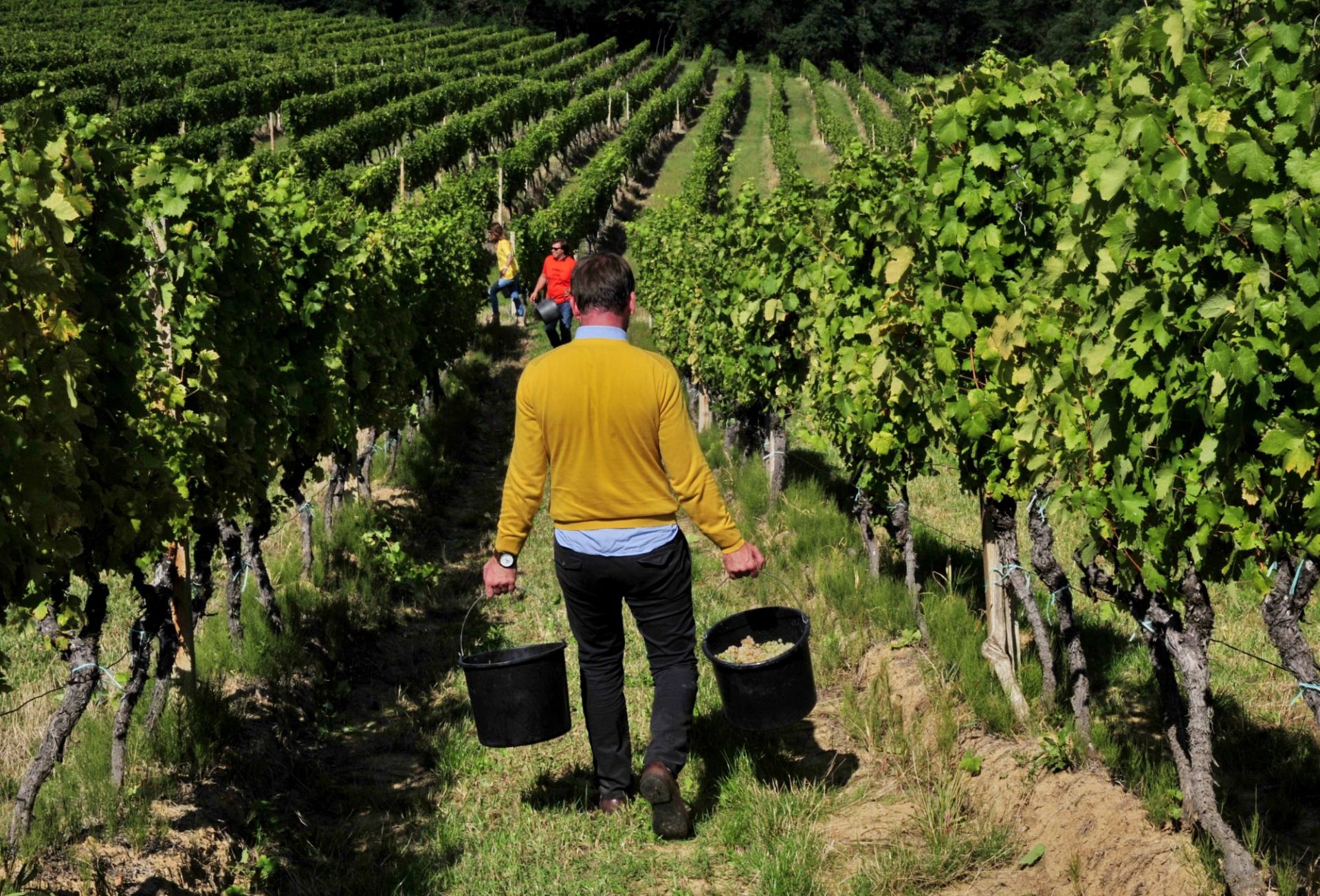Appellation: Saint Amour (pronounced “sant-a-more”)
Geographical Location: Saint-Amour is the most northerly located of the Beaujolais Cru, positioned just south of the Mâconnais regions of Pouilly Fuissé and Saint-Véran. It is also the second smallest, with only Chenas to the south having less area under vine.
In Saint-Amour there are around 800 acres (320 ha) planted to the Gamay varietal, with most of these being on the south and east facing hillsides on the western banks of the Saone river, the angle and elevation of the vineyards here being most suitable for maximum exposure to sunlight.
Topography: The region is markedly more hilly than those to the south with elevations ranging from 202 – 475 m (663 –1,558 ft). This is something of an advantage for Saint-Amour as the hills to the west shelter many of the vineyards for any heavy weather systems coming in from the north. These hillside vineyards of Saint-Amour are often harvested earlier than the flatter vineyards found to the south.
This particular topography gives rise to warm, dry winds that serve to keep much of the moisture from the vineyards, hence Saint-Amour is less prone to fungal disease pressure than other Beaujolais cru. With this in mind, it is interesting to note that organic viticulture is currently going through a nascent phase, with only a handful of certified and non-certified producers making wine from organically grown grapes, although the region shows tremendous potential for the expansion of this. The establishment of a number of micronegotiants making small amounts of excellent Saint-Amour is testament to the winds of change that lie ahead for this region.
Soils: The lightly textured soils of Saint-Amour are composed of an intermingling of Granite, Clay, Schist, and Limestone, and it is these varied soils that contribute to the distinctive mineral elements that come through on many of the region’s wines.
Grape Varietals: Although Gamay is by far the dominant grape in Saint-Amour there are also sizeable plantings of both Chardonnay and Aligoté in the ground. However, these cannot be called Saint-Amour and are usually labelled under the more generic Beaujolais Blanc designation, and occasionally under Saint-Véran, as this Mâconnais region slightly overlaps with that of Saint-Amour.
 History: It is said by some that the commune of Saint-Amour-Bellevue was named after a Roman soldier who, after escaping death in battle, converted to Christianity and established a mission/monastery in the area somewhere around the 4th Century AD.
History: It is said by some that the commune of Saint-Amour-Bellevue was named after a Roman soldier who, after escaping death in battle, converted to Christianity and established a mission/monastery in the area somewhere around the 4th Century AD.
This soldier was later canonized as St. Amateur, the French word amateur occasionally meaning lover/enthusiast, but without any of the sexual connotations that surround the word today. All of this has to be taken with of a bit of a pinch of salt, as is the case with many wine stories…
It is because of this that Saint-Amour is often marketed as the most romantic of the Beaujolais cru, and it’s certainly not coincidental that the appellation sells one-third of its annual production of about 1.6 million bottles on Valentine’s Day each year, according to Jérémie Giloux, president of the Saint-Amour viticultural syndicate. Embracing this connection, in 2015 the Mayor of Saint-Amour-Bellevue organised a Valentines Day wedding of some 300 couples to draw attention to the romantic history of the wines of Saint-Amour.
Local producers, mostly larger scale Negociants (read: merchants) as only 20% of the region’s 115 growers make estate bottled wine, have seized upon this sales opportunity and take full advantage of this particular appellation’s rules that permit them to release their wines a full month and a half earlier than the other nine Beaujolais crus to ensure the year’s vintage is available for Valentine’s Day.
Although most Beaujolais Cru were established in the 1930s, Saint-Amour did not gain this designation until 1946.
Wine Styles: The wines of Saint-Amour can be classed into two quite distinct categories.
First we have the lighter, fruitier, easy-drinking wines that have gone through a quicker maceration and are best consumed within 12 – 15 months of the harvest.
Then we have the bolder, more intense, structured, and usually more mineral-focused wines that have seen a longer maceration. These wines usually drink their best somewhere from four to 12 years after the the harvest, although it is rare to see Saint-Amour with this much age on it as most are unaware that the best examples are quite ageworthy.
What with the varied soil composition, the wines of this small region can vary quite dramatically. Typically one will find expressive fruity and floral aromatics that often include red berry fruits (strawberry, raspberry), mignonette (not the sauce but another name for the fragrant Reseda flower), peony, stone fruits (namely peach and apricot), kirsch, and delicate peppery spice that is reminiscent of pink peppercorns.
The palate of Saint-Amour wines is often seen as one of the lightest and most delicate of all the Beaujolais crus, the very best examples being extremely tender and harmoniously balanced, with a pleasant crunchy acidity, delicate tannins, and a very distinctive mineral expression on the back of the palate.
In my experience I’ve often found that a good sign of a better quality Saint-Amour is the absence of a cooked fruit or cassis character, as this is often indicative of a wine that has gone through the thermovinification process. Thermovinification is a process where the wine is heated to over 140 degrees fahrenheit in order to stablise the wine for transit. Unfortunately this stablisation also leads to a certain amount of standardisation, taking the charming Saint-Amour soul from the wine.
Food Pairing: Served just a little chilled, not only do the wines of Saint-Amour drink well by themselves but, like most wines from Beaujolais, are marvellously versatile when it comes to pairing at both the picnic or dinner table.
I have found most success pairing Saint-Amour with many of the more tradition pairings such as patés, terrines, rillettes, jambon blanc, white-rinded cheeses such as Brie and Camembert, and also with simple roasted chicken with butter, garlic, lemon, and thyme. But all that being said, I’ve also had great joy pairing with milder curries (both Indian korma and Thai green) as well as being wonderfully surprised when I tasted it alongside some unagi (grilled eel) sushi.
The LCBO only bring in Saint Amour around once a year, so keep an eye out for it every time there is a vintages release!
2015 1752 Baptiste & Laurent Saint Amour 1752 Signature Wines “Le Meilleur des 2 Mondes”, Beaujolais, France (Alcohol 13.5%) LCBO Vintages $19.95 (75ml bottle)
A smashing example of the delicacies of this lovely Cru, if only there were more in the system! Having a look online today I can see that many people must enjoy it just as much as I do. The nose here is one of violets, cocoa powder, ripe nectarine, and a whiff of smoke. The palate is both generous and elegant, with lovely black and red cherries by the basketful. Medium-minus in body, but with an admirable pure fruit core with a gorgeous thread of juicy acidity that keeps one going back to the bottle for another glass… over and over again.
![]()
(Four apples out of a possible five)

Edinburgh-born/Toronto-based Sommelier, consultant, writer, judge, and educator Jamie Drummond is the Director of Programs/Editor of Good Food Revolution… And he’s been a life-long lover of Beaujolais.









